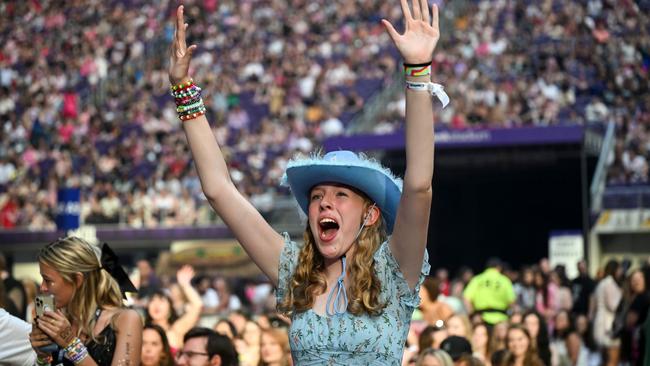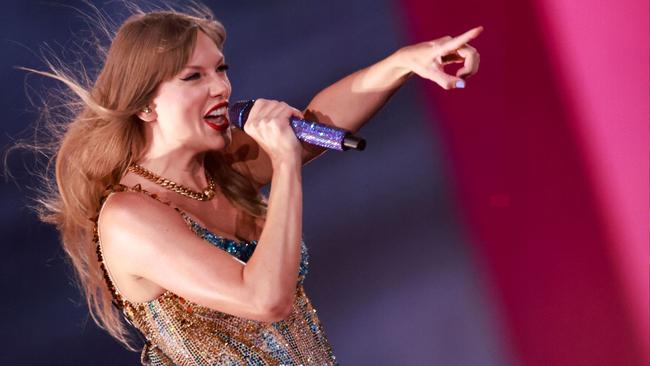The psychology of Swifties: Why Taylor Swift hysteria rivals Beatlemania
At just 34 she’s the biggest cultural phenomenon of the century. So how has the Swift machine enchanted generations of fans? Tell us your pick for pop music’s greatest.

Entertainment
Don't miss out on the headlines from Entertainment. Followed categories will be added to My News.
When The Beatles arrived in Australia on June 11, 1964, they were met with scenes of mass hysteria.
It’s hard not to draw comparisons to the looming arrival of, inarguably, the biggest name in music since the boys from Liverpool – with Swifties taking over the nation in anticipation of the 34-year-old artist who broke an Australian ticket record.
The numbers don’t lie.
Between tickets, flights, accommodation and tourism spend, Swift is expected to pump an eye-watering $346 million into Australia’s economy. Her three-and-a-half hour Eras Tour shows are expected to be the first to gross more than US$1bn.
SOMEONE ELSE? TELL US IN THE COMMENTS
In 2023, Swift broke Elvis Presley’s long-held record for most weeks spent at No 1 on the Billboard album chart as a solo artist. She now has the most No 1 albums by a woman in history.
She had three songs in the Hot 100 charts at once – a feat only achieved otherwise by The Beatles.
Her Eras Tour concert film became the highest-grossing of all time, earning US$261.6 million worldwide.


Tears, joy, costumes, carpooling, bracelets, chants, Easter eggs and megafans are all part of the Taylor Swift force majeure, which has been proven more economically impactful than the Superbowl.
All of this has been achieved with a barrier The Beatles never faced – she’s a woman.
So what is it about Swift’s generation-spanning musical appeal that has enchanted the globe?
Dozens of universities now have entire courses dedicated to Swift, from “The Psychology of Taylor Swift” to “Literature: Taylor’s Version”, attempting to nail down just what’s made the former country star such an enduring presence.
Marketing prowess, versatile musicality and critical acclaim are all pieces of the puzzle – but Swift’s success arguably lies mostly with her masterful songwriting.
While later tracks from albums Folklore and Evermore, many of which were produced hand-in-hand with The National’s Aaron Dessner, have been hailed for their poetry-like lyricism, it’s the sum of her catalogue that shows her hand at capturing entire generations.
Her eponymous debut Taylor Swift, Fearless and Speak Now lament on the heartaches of high school love in the language of teenagers, while Red and 1989 grow in their production and themes for an older audience.
Reputation is an ode to love and hardship, with the bloodsport of an older-but-wiser young woman who has learnt the world isn’t always their friend, while Lover matures even further both musically and thematically.

Perhaps a messy split from former label Big Machine Records – and the buyer of her albums, Scooter Braun – was the catalyst that pushed Swift from country-pop darling into megastardom.
On February 11, 2021, Swift released a re-recorded Fearless with an additional moniker: “Taylor’s Version”, to signify that she now owned the entirety of her product.
The move not only gave Swift full control of her catalogue, but reintroduced the 2008-penned tracks to an entirely new audience.
Fast forward to 2023 and Swift’s hotly-anticipated version of 1989 – first released in 2014 – smashed sales records in the US.
Past detractors of Swift’s music have labelled it “petulant”, criticising it for its focus on “boys and romance” – but for her fans, that’s the heart of her appeal.
Swift deftly captures the universal pain of heartbreak, the joys of young love and the challenges of rejection.
She speaks particularly to women – an audience whose value is often demeaned by music critics as “lesser” for no reason other than being female – by reminding them their experiences are not just valid, but shared.
Flinders University Professor Emma Thomas said the idea of social identity was at the heart of Swiftmania, creating psychological connections between not just each fan and Swift, but with each other.

“There are parts of who we are that we can share with other people – these are termed “social identities”, which reflect aspects of our self that we share with other people,” Prof Thomas said.
“ Identity is the psychological reason for the close sense of connection and oneness that fans often report feeling with Taylor herself … and with other people who are also Swifties.
“Imagine a concert where you are entirely by yourself. It would not be half so enjoyable – there are huge hedonic and wellbeing pay-offs from sharing an identity and enacting it with other people.”
Leading wellbeing researcher Ros Ben-Moshe said Swift’s authenticity had also played a pivotal role in her influence, offering refreshingly real inspiration to young people who had grown alongside her.
She has championed both women’s and artists’ rights and fought against sexist scrutiny with vulnerability and honesty.
“Celebrities are often worshipped as infallible and limited to the dimension we see in the public sphere, but Taylor does not paint herself as perfect – whether addressing her fluctuating weight from an unhealthy 00 to size 6, or openly sharing her growth journey,” Ms Ben-Moshe said.
“Taylor (is) a role model for leading life with humour, authenticity, and commitment to happiness and in so doing cultivating personal resilience and joy.
“She doesn’t hesitate to express her genuine thoughts and emotions through her music and she’s also candid about the importance of being authentic and true to yourself.”
More Coverage
Originally published as The psychology of Swifties: Why Taylor Swift hysteria rivals Beatlemania





